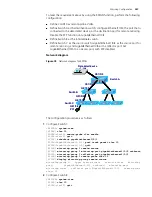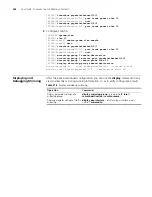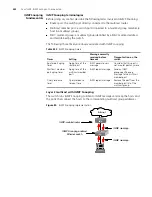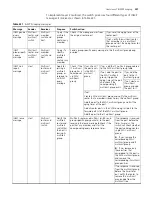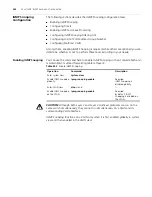
28
C
ONFIGURATION
FOR
M
IRRORING
F
EATURES
Mirroring Features
Mirroring refers to the process of copying packets that meet the specified rules to a
destination port. Generally, a destination port is connected to a data detect device,
which users can use to analyze the mirrored packets for monitoring and
troubleshooting the network.
Figure 76
Mirroring
Traffic Mirroring
Uses ACLs to identify traffic flows and mirror packets that match to the destination
port.
Port Mirroring
Port mirroring refers to the process of copying the packets received or sent by the
specified port to the destination port.
Remote Port
Mirroring—RSPAN
Remote switched port analyzer (RSPAN) refers to remote port mirroring. It eliminates
the limitation that the mirrored port and the mirroring port must be located on the
same switch. This feature makes it possible for the mirrored port and the mirroring
port to be located across several devices in the network, and facilitates the network
administrator to manage remote switches.
The application of RSPAN is illustrated in Figure 76:
Figure 77
RSPAN application
There are three types of switches with the RSPAN enabled.
■
Source switch: the switch to which the monitored port belongs.
Destination port
Data detect device
PC
Netw ork
Destination port
Data detect device
PC
Netw ork
Source
Switch
Intermediate Switch
Destination
Switch
Reflector port
Source Port
Trunk port
Destination port
Remote-probe VLAN
Source
Switch
Intermediate Switch
Destination
Switch
Reflector port
Source Port
Trunk port
Destination port
Remote-probe VLAN
Summary of Contents for 4200G 12-Port
Page 10: ...8 CONTENTS...
Page 14: ...4 ABOUT THIS GUIDE...
Page 46: ...32 CHAPTER 5 LOGGING IN THROUGH WEB BASED NETWORK MANAGEMENT SYSTEM...
Page 48: ...34 CHAPTER 6 LOGGING IN THROUGH NMS...
Page 60: ...46 CHAPTER 9 VLAN CONFIGURATION...
Page 64: ...50 CHAPTER 10 MANAGEMENT VLAN CONFIGURATION...
Page 80: ...66 CHAPTER 13 GVRP CONFIGURATION...
Page 98: ...84 CHAPTER 15 LINK AGGREGATION CONFIGURATION...
Page 112: ...98 CHAPTER 18 MAC ADDRESS TABLE MANAGEMENT...
Page 126: ...112 CHAPTER 19 LOGGING IN THROUGH TELNET...
Page 162: ...148 CHAPTER 20 MSTP CONFIGURATION...
Page 274: ...260 CHAPTER 29 IGMP SNOOPING CONFIGURATION...
Page 276: ...262 CHAPTER 30 ROUTING PORT JOIN TO MULTICAST GROUP CONFIGURATION...
Page 298: ...284 CHAPTER 33 SNMP CONFIGURATION...
Page 304: ...290 CHAPTER 34 RMON CONFIGURATION...
Page 338: ...324 CHAPTER 36 SSH TERMINAL SERVICES...
Page 356: ...342 CHAPTER 38 FTP AND TFTP CONFIGURATION...
Page 365: ...Information Center Configuration Example 351 S4200G terminal logging...
Page 366: ...352 CHAPTER 39 INFORMATION CENTER...
Page 378: ...364 CHAPTER 40 BOOTROM AND HOST SOFTWARE LOADING...
Page 384: ...370 CHAPTER 41 Basic System Configuration and Debugging...
Page 388: ...374 CHAPTER 43 NETWORK CONNECTIVITY TEST...
Page 406: ...392 CHAPTER 45 CONFIGURATION OF NEWLY ADDED CLUSTER FUNCTIONS...

























